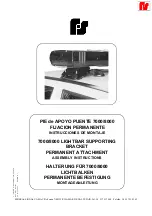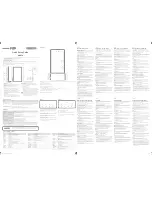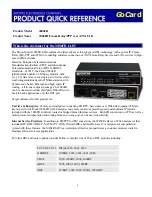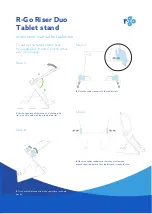
Description
Modulated infrared barrier consisting of a transmitter and a receiver.
The equipment is housed in a shockproof and waterproof plastic cas-
ing.
The adjustable lens, set on a self lubricating and self locking ball joint,
can be adjusted through
180° horizontally and plus or minus 30°
vertically.
The equipment has a double relay with serial exchange. The NC contact
conforms to category 3 of the directive
UNI EN ISO 13849-1 (update
of the
EN954-1).
It is possible to connect up to 3 pairs of photocells and synchronize
the transmission (multiplex system).
Use:
The infrared barrier constitutes an efficient safety system for the pro-
tection of passageways or spaces which are equipped with automatic
door or gate systems.
The use and installation of these devices must respect the safety
standards and regulations in force.
Versions
CDR999 The package contains the components required for surface
installations:
- 1 transmitter ; 1 receiver; set of screws and gaskets
Technical specifications
- Infrared emission obtained through the use of a double emitter
GaAs
(Galium Arsenide) diode with range
25 kHz and continuous modulation
at
70 Hz;
- Infrared emission wavelength:
950 nm;
- Power supply:
12 - 24 Vac/dc;
- Maximum commutable relay power with resistive load:
28W in dc/60VA in ac; max. voltage 30 Vac/dc; max. current 500
mA
- Intervention time:
30 ms (single photoelectric cells); 100 ms (for a
multiplex system)
- Power consumption:
12 Vac/dc, 51 mA for the re 31 mA for the transmitter
24 Vac/dc, 53 mA for the re 33 mA for the transmitter
- Operating temperature:
-10…+55°C;
- Protection grade
IP55
- Range:
10 m under all weather conditions such as thick fog, rain and dust
etc.
Transmitter (fig. 4):
- Green power on led;
- Dip-switch "
D2" multiplex installation settings.
Receiver (fig. 3):
Attention: The photoelectric cell carries out an internal auto test
every minute, it is therefore normal that when the system is at rest,
the red LED will light for an instant every minute.
- Red led lit continuously: photocell disturbed or misaligned;
- Red led lit flashing each second: photocell not functioning;
- Test point for fine tuning;
- Dip-switch "
D1" multiplex installation settings and relay delay
mode;
- Jumper "
J1" for selecting the output mode (potential free or resistive
contact
8,2 k
Ω
).
Installation
Note: In cases where the installation consists of more than one device
you are advised to use the multiplex function so as to avoid interference
between the beams. In this case each transmitter is associated with its
receiver by setting dips 1 and 2 identically on both.
SURFACE MOUNTED INSTALLATION
Installation is possible on all types of structure.
Other than the standard aligned positioning the device can also be
positioned both laterally (moving the device out of the passageway)
and at different heights in order to solve problems posed by different
structures ( detail a-b-c-d, fig. 5).
Note: in installations where the infrared beam passes through the
highly curved parts of the cover the maximum range of the devices
could be reduced.
• To correctly install the device proceed as follows:
Attention! The electronic card must never be removed from its sup-
port base. Only use the screws supplied with the devices.
- to open and close the container carefully follow the sequence shown
in fig. 2;
- choose the points at which the devices are to be surface mounted,
according to the requirements of the system;
- work out the run of the cables from the structure to the point of con-
nection;
- using the
template supplied with the package trace the positioning
holes (“
D” fig. 6);
- fasten the base and relative sealing gasket to the wall (“
A” fig. 6), making
sure that you use the washer supplied with the package, and pass the
wiring through the hole “
B”;
- carry out the electrical connection (fig. 3, 4);
- align the projector and the receiver by rotating the optic and check that
the optic lock nut is well tightened (fig. 7);
- replace the infrared cover by placing it against the lower seal and rotat-
ing it until you hear the click meaning the holding teeth have locked
the cover (see "
A" fig. 2);
- when fine tuning the beam (upwards and downwards) it is possible to
insert a pointed tool into the upper slot on the optic (see "
A" fig. 7);
- to close the infrared cover only use the two screws that are housed,
separately in the upper compartment of the bag of screws (see detail
“1” fig. 2”).
Connections and setting
- carry out the electrical connection as shown in the drawings (fig.
3,4);
- set jumper "
J1" according to the type of relay output;
- jumper inserted: potential free contact
(C-NO-NC);
- jumper not inserted:
8,2 k
Ω
output (8,2 k
Ω
between binding
posts 4 and 6 at rest)
- set all the dip switches to "
OFF" both on the receiver and the transmit-
ter;
- power up the receiver and transmitter: The green LED on the transmitter
should remain lit constantly and the red LED on the receiver should be lit
if the photoelectric cells are not aligned and OFF if they are aligned;
- the minimum allowed cable cross section is:
0.2 mm
2
(
AWG #24)
Connections and centring
- insert the probes of a normal tester
(lowest setting
2 Vdc) into the test point
maintaining the correct polarity as indi-
cated on the p.c.b card;
- centre the lenses so you obtain a maxi-
mum reading on the tester referring to
the distance/test point table;
- the values shown in the table are indicative parameters and depend
on the atmospheric conditions
Multiplex system (max. three pairs)
- position all the transmitters on the same side;
- connect all the
SYNC inputs on the receivers in parallel and connect
the
GND inputs in parallel;
- power up the pairs of photoelectric cells and centre them by following
the paragraph "
Connections and centring";
- carry out the centring procedure separately
for each pair of photoelectric cells. Set the
dips 1 and 2 on each pair of photoelectric
cells (transmitter and receiver) progressively
according to the configuration laid out in the
table on the right and starting with the master
pair of photoelectric cells;
- power up all the pairs of photoelectric cells and you have finished set-
ting the multiplex installation.
MODULATED INFRARED BARRIER
PAIR
dip 1 dip 2
1
ON OFF
2
OFF ON
3
ON ON
Distance (m)
Test point value
3
1,6
5
1,2
8
0,7
10
0,4
Téléchargé sur www.confort-electrique.fr
Retrouvez tous les produits du fabricant Cardin sur notre site internet www.confort-electrique.fr
Téléchargé sur www.confort-electrique.fr
Retrouvez tous les produits du fabricant Cardin sur notre site internet www.confort-electrique.fr























